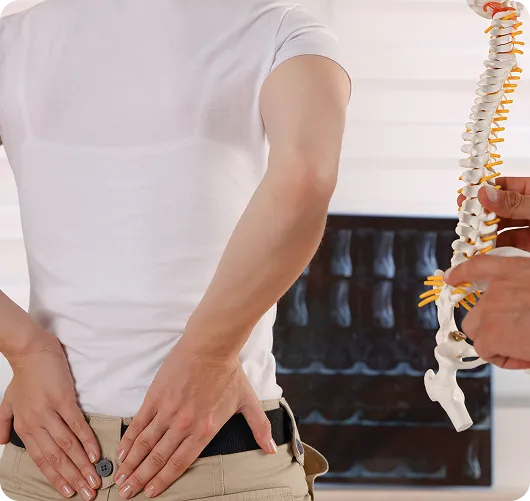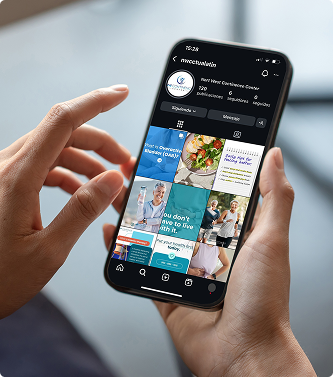Relief for Post-Surgical Spine Pain
Targeted treatments to relieve pain after spine surgery

Understanding Post-Surgical Pain and FBSS
Although complications after spinal surgery are uncommon, some patients experience ongoing pain known as failed back surgery syndrome (FBSS). This condition can significantly affect physical health and lead to chronic discomfort after certain procedures, such as spinal fusion, laminectomy, or decompression surgery.
Common signs include persistent pain in the neck, back, legs, or arms, as well as numbness, muscle weakness, and reduced mobility. FBSS can interfere with your ability to perform everyday tasks and lower your overall quality of life. Seeking specialized care early is key to preventing further complications and achieving better outcomes.
Understanding Post-Surgical Pain and FBSS
Although complications after spinal surgery are uncommon, some patients experience ongoing pain known as failed back surgery syndrome (FBSS). This condition can significantly affect physical health and lead to chronic discomfort after certain procedures, such as spinal fusion, laminectomy, or decompression surgery.
Common signs include persistent pain in the neck, back, legs, or arms, as well as numbness, muscle weakness, and reduced mobility. FBSS can interfere with your ability to perform everyday tasks and lower your overall quality of life. Seeking specialized care early is key to preventing further complications and achieving better outcomes.

Causes of Post-Surgical Pain
Several factors can contribute to post-surgical pain or FBSS, including:
Incomplete decompression of nerves: If the procedure doesn’t fully relieve nerve pressure, pain signals may persist.
Recurrent disc herniation: New herniations can occur due to the sensitivity of the disc tissue.
Scar tissue formation: While scar tissue is a natural part of healing, excess tissue can sometimes press on nerves and cause pain.
Persistent or recurrent spinal stenosis: Even after surgery, spinal stenosis may return, leading to recurring lumbar pain.
Spinal instability or deformity: Some procedures may alter spinal structure and lead to instability or misalignment.
Misdiagnosis of the original condition: If the initial spinal issue was not accurately identified, pain may continue after surgery.
Symptoms of Post-Surgical Pain
Post-surgical pain can vary in intensity and location, depending on the cause and the type of spinal procedure performed. In cases of FBSS, symptoms may persist or worsen over time, affecting mobility and daily activities. Recognizing these signs early is essential to begin effective treatment and prevent long-term complications.
✔ Ongoing pain in the back or legs
✔ Numbness or tingling in the extremities
✔ Weakness in the legs or feet
✔ Difficulty standing or walking for long periods
✔ Limited range of motion or flexibility
Treatment Options for Post-Surgical Pain
Since the causes of FBSS can vary, treatment is tailored to each patient’s condition and pain level. Options may include:
Minimally Invasive Intervention
These procedures involve smaller incisions, fewer risks, and shorter recovery times compared to traditional surgery. For example, minimally invasive lumbar decompression (MILD) relieves pressure on spinal nerves by removing small amounts of bone or tissue through a tiny incision.
Pain Management Procedures
These techniques help reduce or block pain signals sent to the brain:
✔ Radiofrequency ablation: Uses heat to minimize nerve irritation
✔ Facet joint injections: Target inflamed spinal joints that may cause pain post-surgery
Neuromodulation
This treatment modifies how the nervous system processes pain. Spinal cord stimulation, for instance, involves placing a small device near the spine that sends electrical pulses to block pain signals.
Injections
Epidural steroid injections deliver anti-inflammatory medication into the epidural space to relieve nerve compression and provide fast-acting, temporary pain relief.
Non-Opioid Medications
These medications help control pain without the risk of opioid addiction. Options may include:
✔ Nonsteroidal anti-inflammatory drugs (NSAIDs)
✔ Muscle relaxants
✔ Anticonvulsants
✔ Antidepressants
✔ Topical analgesics
Therapies & Lifestyle Changes
Complementary approaches can enhance treatment outcomes and improve long-term well-being:
✔ Massage therapy
✔ Acupuncture
✔ Chiropractic care
✔ Low-impact physical activity
✔ Maintaining a healthy weight
✔ Eating a balanced diet

Care That’s Close to Home
We offer care from two convenient clinic locations, making it easy to access expert medical support close to home.
Each facility is designed to provide a welcoming, safe, and efficient environment equipped with advanced technology and supported by a compassionate team dedicated to your well being.
Care That’s Close to Home
We offer care from two convenient clinic locations, making it easy to access expert medical support close to home.
Each facility is designed to provide a welcoming, safe, and efficient environment equipped with advanced technology and supported by a compassionate team dedicated to your well being.

Why Choose Spinal Diagnostics?
Patients choose Spinal Diagnostics for our comprehensive approach, accurate diagnostics, and compassionate care. We stay at the forefront of interventional procedures and are committed to improving your quality of life without opioids or invasive surgeries.
Proven Medical Expertise
We bring years of clinical experience in pain management and interventional procedures.
Constant Innovation
We use the latest techniques and technology to ensure safe, effective treatment.
Compassionate Care
We listen, understand, and treat every patient with empathy and respect.
Personalized Plans
Each treatment is tailored to your condition, goals, and lifestyle.
Explore the treatments that bring real relief.
Learn how our non-invasive solutions and personalized plans can help you feel better, faster.
Explore the treatments that bring real relief.
Learn how our non-invasive solutions and personalized plans can help you feel better, faster.


